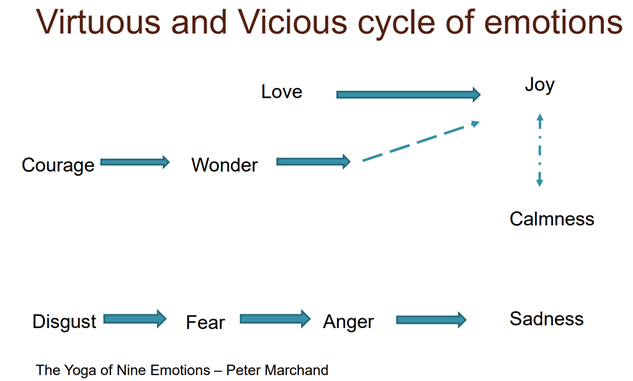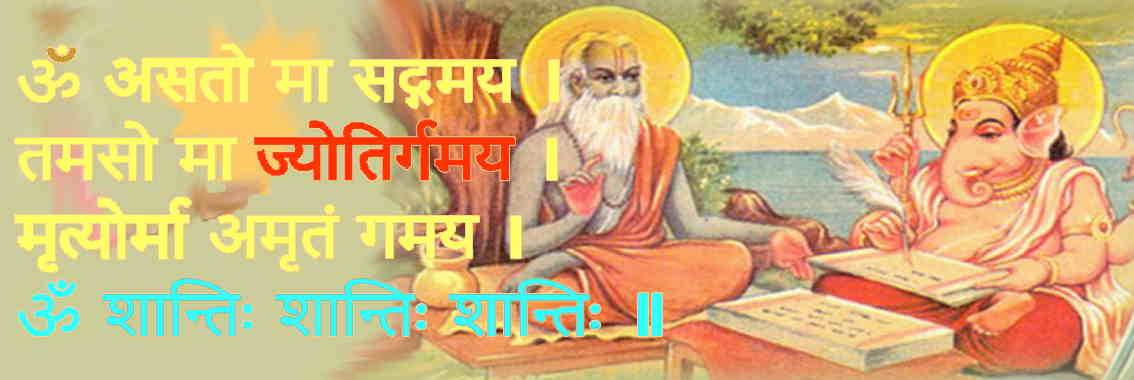Śama – Equanimity
व्यां वेदव्यासाय नमः
vyāṁ vedavyāsāya namaḥ
Guru Purnima is the occasion to express gratitude to our Guru, mentors and teachers who are illumining our path. This year, it falls on July 13th. Three years ago, on this same occasion I wrote about how the importance of observing “Sadhana Chatushtaya” or the four-fold qualification given in Tattva Bodha that facilitates learning. https://vijayajyoti.com/guru-purnima/. Being aware of these requirements is a preliminary step in the path of spiritual progress. The more qualifications we gain, the better will be the assimilation of knowledge and the in the practice of it. When there is a conflict in theory and practice, then one must re-visit these qualifications to see what is being not followed. Every year I explore one quality in-depth for development as my offering on this day. I have explored in the previous years the importance of quality of Titīkṣa and Śraddhā.
This year I want to explore the quality of śama and what it means for me. I took this topic up as I recently lost my balance talking to someone who I felt was unfairly judging me while I wanted to be liked by that person. Instead of accepting we disagree and remaining calm, I explained away more and more on the call like a child only to hear more of judgement which left me raising my voice sounding agitated in frustration as I feared rejection. I did meet my destiny. This could happen to any of us dealing with those we are close to or want to impress.
What is śama?
Śama (शम) is defined in the dictionary as tranquillity, calmness, peace, equanimity, quietude, absence of passion, abstraction from eternal objects through intense meditation.
In a classical beginner’s book for Vedanta Philosophy Tattva Bodha, śama is defined as “mano nigraha” – meaning control or restraint of mind. Immediately I am reminded of the verse (1.3.3-11) from Kaṭhopaniṣad about the metaphor of a chariot (ratha kalpana) used to describe the relationship between the senses, mind, intellect and the Self. The body is equated to a chariot where the horses are the senses, the mind is the reins, and the charioteer is the intellect. The passenger of the chariot is the Self (Atman). The reigns (mind) should be tight held by the charioteer (intellect) to reach the destination otherwise one can run amok or pulled by the five horses (senses) that dwell on what life throws in its way. However, this control is not understood as repression but a honing of the mind and senses to be optimum and efficient.
Swāmī Paramārthānandā of Arśa Vidya Gurukulam teaches that śama is shanti or peace of mind, rather a poise of mind – a mind that is free from stress and strain. He includes sama or samatvam or being in equipoise.
Sama (सम) is the quality that is needed for correct discernment of any situation. When our mind is overtaken or held hostage by emotions the judgement is often clouded and we are unable to “see” correctly. Śri Kṛṣṇa in Bhagavad Gītā brings up sama or samatva many times (Verses 2.15, 6.8, 2.48, 14.24 and 14.25) and advises us to stand still in the field of opposites to achieve the equanimity towards the path of spiritual progress or liberation.
समदु:खसुख: स्वस्थ: समलोष्टाश्मकाञ्चन: |
तुल्यप्रियाप्रियो धीरस्तुल्यनिन्दात्मसंस्तुति: || 14. 24||
मानापमानयोस्तुल्यस्तुल्यो मित्रारिपक्षयो: |
सर्वारम्भपरित्यागी गुणातीत: स उच्यते || 14. 25||
sama-duḥkha-sukhaḥ sva-sthaḥ sama-loṣhṭāśhma-kāñchanaḥ
tulya-priyāpriyo dhīras tulya-nindātma-sanstutiḥ
mānāpamānayos tulyas tulyo mitrāri-pakṣhayoḥ
sarvārambha-parityāgī guṇātītaḥ sa uchyate
Those who are alike in happiness and distress; who are established in the self; who look upon a clod, a stone, and a piece of gold as of equal value; who remain the same amidst pleasant and unpleasant events; who are intelligent; who accept both blame and praise with equanimity; who remain the same in honour and dishonour; who treat both friend and foe alike; and who have abandoned all enterprises – they are said to have risen above the three guṇas.
The literal definition of guṇa is “a single thread or strand of a cord or twine”-or that which binds. From the Bhagavad Gītā, the material universe is balance of three guṇas – Sattva, Rajas and Tamas. Sattva guṇa is the mode of goodness, pure, illuminating and binds the soul by creating attachment for to happiness and knowledge. Rajas guṇa arises from worldly desires and affections, and binds the soul through attachment to furtive actions. Tamas guṇa is born of ignorance and deludes all living beings through negligence, laziness, and sleep and causes the soul to be trapped in illusion. The guṇas are made up of experiences from this life and past lives, as well as from circumstances both external and internal (which includes our body and senses) and are usually acted upon in daily life by our identity (ahaṅkāra). On the death of the human being, it is said that while the gross body drops, the causal and subtle body including our mind, memories, experiences and habits travels along with the individual soul to the next destination to be exhausted and experienced in the next life. This is why we are so bound by her past experiences that it very difficult for us to change habits or thought patterns.
More importantly the importance of transcending over the opposites – dvanda is being highlighted in the verse. As we gravitate from one side to the other, we are firmly bound by the world. When are freed from the opposites, then we have been able to transcend the forces of the material world, our saṁskāra and vāsanās.
Sometimes I wonder how do we transcend the guṇas and be equanimous when destiny laughs at us. Is it truly possible to remain equanimous like Śri Rāma who when deprived of his crown-prince status dutifully went to the forest to comply with his father’s vows. We all experience the highs and lows in life, one moment we feel loved and at others we despair being ghosted. How do we manage the twists in our path with dignity? How do we keep the lid on our desires and aversions?
Understanding polarities to attaining equanimity
In psychology, the concept of opposites is described as Polarities. We are familiar how in a moment, when we are looking at something and holding to understanding from one particular point of view, we are unable to see the other side and therefore we remain with differences or limiting beliefs. When we dislike something, we are unable to see the goodness it has, it is very difficult to be impartial. These days we can see in the social media where people vent their side of arguments without being objective and some even attack those who keep an even perspective.
However polarities are natural and we cannot avoid it. Everything in the universe has an opposite such as North and the South Pole, in good and evil, love and hate, in actions such as breathing in and breathing out, in doing and being and most importantly in the concept of continuity and change. One concept cannot be defined or understood without the other and the existence of opposite is implicit whether it is accepted or denied. The elation of success is understood is nothing but escaping failure. The pain of failure is felt for not being successful. Life is a constant slide up and down this greasy pole of samsara.
To manage polarites is the ability to hold two opposing ideas in your mind at the same time while changing the narrative of the issues we face. The picture below shows a goblet and women. Most people either see the two women’s faces or the goblet. You can’t hold both images in your mind at the same time.

F. Scott Fitzgerald famously wrote: “The test of a first-rate intelligence is the ability to hold two opposing ideas in mind at the same time and still retain the ability to function”. Most great leaders are able to manage polarities well.
When we are imagining a positive situation and feel good it is difficult to feel very angry or fear even when the situation demands so. This is akin to sunny day in London, nobody minds the traffic and everything is fine, but on a typical grey day, even a minor transgression ends up as an unforgiveable offence. When we are feeling negative we are caught in an emotional tunnel and then it is hard to change our mood. From tamasic emotions such as fear and depression it is very difficult to get to joy, its best to attain samatva first. However one can train oneself to change the change moods from negative to positive by bringing consciously to our mind the associations that lead to positive feelings.

Equanimity in daily life
Equanimity is cultivated by maintaining neutrality toward all beings. It is manifested as the quieting of resentment and approval of ourselves and of others. It is being mindful the gap between our likes and dislikes while making sure that we limit grasping all that we like and shun what we dislike. This is not the same as indifference or apathy. Equanimity when practiced well hones the power of observation—the ability to see without being caught by what we see. This leads to correct discernment and inner peace.
The practice of equanimity requires a continuous introspective life. We can observe ourselves objectively to understand what our script (vāsanās) is and how we get triggered by it and react, thereby losing our balance. This process requires understanding and commitment. Meditation does help in quietening the mind but yields better results in daily life when we improving understanding of ourselves by introspecting and becoming aware of our triggers. We should also become aware that sometimes we use the practice of defence or inauthentic speech to limit learning something painful or that is contrary to our beliefs which will ruin our agenda. However, it is alright to stumble along sometimes and get unbalanced. Swāmī Paramārthānandā assures us that being on the path of introspection and reflection continuously leads us to lowering the frequency of such stumbles, the intensity or impact of such incidents is less and therefore the recovery to equanimity is faster.
The pillars of equanimity are non-attachment and acceptance. Again non-attachment is not indifference but making sure we are not excessively attached or willing one particular outcome for ourselves or others around us. In my recent experience where I stumbled, my fear of being judged and rejected by the caller made me lose my balance and I failed to be in the “Here and now”. Belief in the karma theory of “we reap what we sow” and some of it being unavoidable also helps in acceptance which leads to reduced inner conflict.
Faith in higher power also helps with equanimity. Sometimes we are troubled with the injustices that is meted out to us by the people we encounter. Feeling angry can make one lose emotional balance. One thing that works for me sometimes is to be firm in the belief that my account of debit and credit is with a higher power say Śri Kṛṣṇa and not with the people who I meet in life. This helps me deliver with joy without focussing on whether I am getting rewarded correctly. It helps me focus less on the injustices and I am able to experience joy and tranquillity in my mind as I go about my duties. This I learnt from the verse 12.8 from the Bhagavad Gītā as taught by Swāmī Paramārthānandā.
मय्येव मन आधत्स्व मयि बुद्धिं निवेशय |
निवसिष्यसि मय्येव अत ऊर्ध्वं न संशय: || 8||
mayy eva mana ādhatsva mayi buddhiṁ niveśhaya
nivasiṣhyasi mayy eva ata ūrdhvaṁ na sanśhayaḥ
The literal translation of this is “Fix your mind on Me only, place your intellect in Me, then (thereafter) you shall, no doubt, live in Me alone.”
Swāmī Paramārthānandā translates is as follows –
Don’t seek anything from the world, or any people, give to the world and seek from ME (Kṛṣṇa) emotionally learn to depend on ME (Kṛṣṇa)
Equanimity leads to peace and liberation
True happiness which is not merely excitement but joy and this is the result of equanimity. Another quality to acquire on the way to equanimity is the quality of contentment – santuṣṭha (सन्तुष्ठ). Contentment is opposite to grasping – parigraha (परिग्रह) and manipulation of events for achieving ends. According to verse 6.15 of the Bhagavad Gītā, the yogi who is content with knowledge and discrimination, and has conquered their senses, remain undisturbed in all circumstances and become eligible for liberation.
Verse 4.22 of Bhagavad Gītā talks about how contentment and freedom from polarities helps in breaking the bonds of samsara towards liberation. “Content with whatever gain comes of its own accord, and free from envy, they are beyond the dualities of life. Being equipoised in success and failure, they are not bound by their actions, even while performing all kinds of activities”.
Human beings would be the same if it were not for the minds. It is our minds that make us extraordinary, normal or not. It is the disciplined mind that leads one to our destination. A disciplined and well introspected mind can access its higher form and achieve a lightness to it as it not weighed by the polarities. It becomes agile in accomplishing goals. This lightness makes us able to transcend our existing patterns of thinking – guṇas (attributes) and proceed towards our liberation.
The concept of a light heart and equanimity as a key to evolution and emancipation was known to all ancient cultures. As per the Book of the Dead of the Egyptians, to reach the eternal paradise of the “Field of Reeds” one had to pass through the trial by Osiris, Lord of the Underworld and Judge of the Dead, in the Hall of Truth and this trial involved the weighing of one’s heart against the feather of Maat – truth. If one lived with a proper moral code then the heart balanced with the feather and they deceased soul was allowed to live eternally in the Field of Reeds”.
I end this exploratory essay with this quote from —Dhammapada 81-83 on Equanimity
As a solid mass of rock
Is not stirred by the wind,
So a sage is not moved
By praise and blame.
As a deep lake
Is clear and undisturbed,
So a sage becomes clear
Upon hearing the Dharma.
Virtuous people always let go.
They don’t prattle about pleasures and desires.
Touched by happiness and then by suffering,
The sage shows no sign of being elated or depressed.
ॐ तत् सत्
References
Teachings of Swāmī Paramārthānandā of Arśa Vidya Gurukulam on Bhagavad Gītā and Upaniṣads
Polarity Management Barry Johnson, (1992)
Yoga of Nine Emotions, Peter Marchand (2006)


Hi Vijaya,
This is a very informative article.
What are your thoughts on the the current political turmoil in UK? Any astrological predictions as to who could be next PM?
Hi Ann. Thank you for your comments. I am writing and doing less this year as I am tackling the last module of a masters programme. So apologies if my comments are not timely. I have a paper to submit next week and trying to keep my head down. Nevertheless I wish that it would be someone who brings a new perspective while keeping the party and country together. The Rahu Mars face off early August should reveal a lot.
Thank you for your reply Vijaya. I love reading your articles.
All the best for your Masters programme!
Very important article.Thank you very much.
Hello Vijaya.
I am new to your website. I had observed you are very knowledgeable and of quite friendly conduct. You solve everyone’s doubt by responding them.
So, I request you to take a look at my planets position also. (I hope you will reply) Let me explain ;
Owner of the ascendant, Lord Moon, is in the 10th house (Aries Sign). Whereas, 2nd house owner (Sun), 4th house owner (Venus), 5th house owner (Mars), 10th house owner (Mars) and 11th house owner (Venus) along North Node (Rahu) are seated in the first house of the Cancer Sign.
In addition, the owner of 7th and 8th house, Lord Saturn along with the owner of 6th and 9th house, Lord Jupiter, are conjuncted in the 11th house of Tarus Sign.
Furthermore, my first house Lord Moon as mentioned earlier present in the 10th house, and the Lord Mars, owner of 5th (Scorpio) and 10th house (Aries), are mutually exchanging houses and creating Parivartan Yoga which maybe also cancels the debilitation of Lord Mars and form a ‘Neech-Bhang Raj Yoga’, hope so.
On contrary to it, in Chalit Chart, Lord Venus, owner of 4th and 11th house is still in 1st house but Lord Moon, owner of first house moves in 11th house of Tarus Sign of Lord Venus forming again a Parivartan Yoga but also gets exalted.
North Node (Rahu) being in first place as addressed earlier automatically results in South Node (Ketu) getting placed in 7th house in the Sign of Capricorn.
At last, Lord Mercury having the ownership of 3rd and 12th house of chart is placed in 12th house.
My name is Ashutosh.
Dear Ashutosh.
Many thanks for your comments. Your question does not pertain to the article I wrote. I only answer questions in context of the articles. Looks like you would like your chart read. You do have a complex chart with 4 planets in the first house and at the end of a graha mallika. You should perhaps write to me for a consultation if you desire comments on your horoscope.